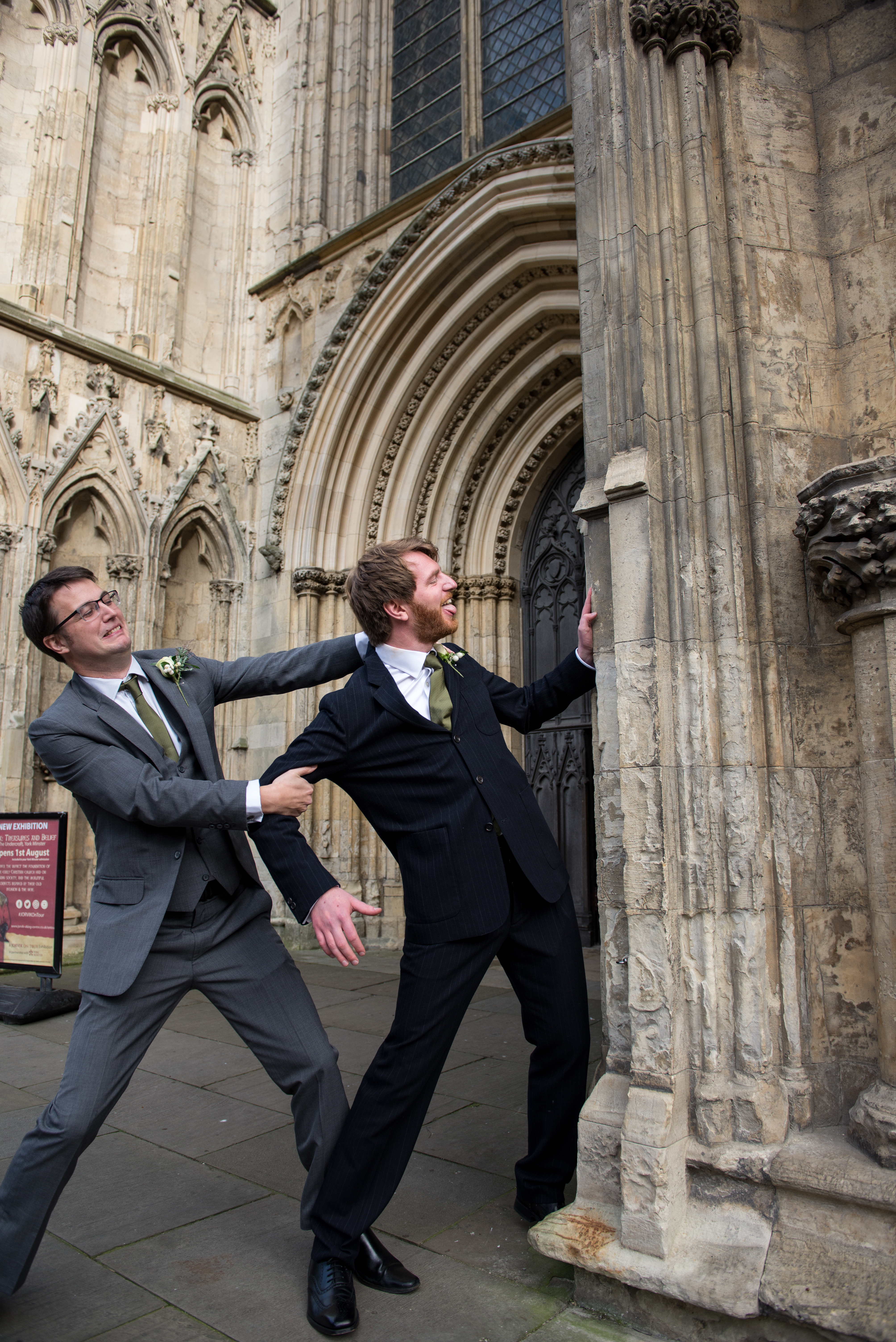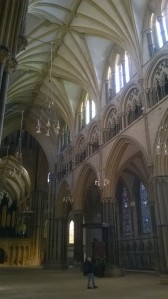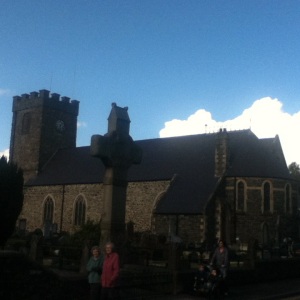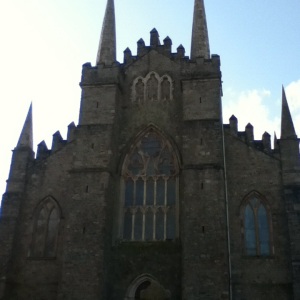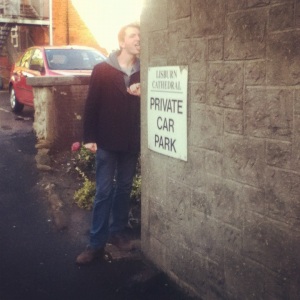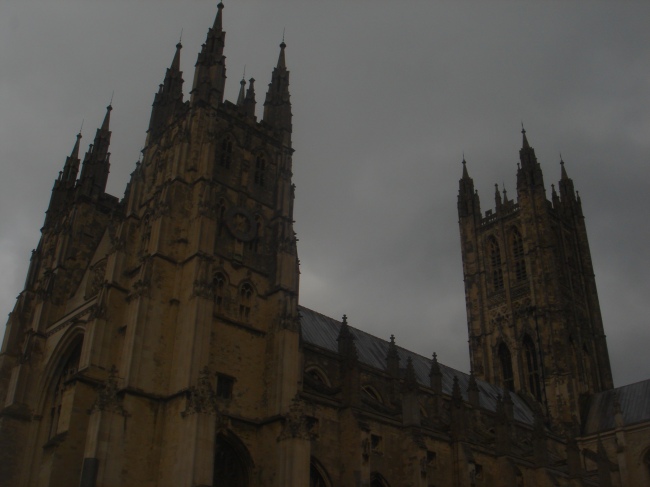
Dear readers, here is a another sample chapter from the cathedral-licking book! It tells the tale of my experiences in Rochester and Canterbury, from very early on in the adventure. Please do let me know your thoughts.
Lawrence
Kent was alive with colour. The early morning light gave its green and mustard coloured fields a healthy, fertile glow and great cathedral-like barns shone with a glossy red. Church spires dotted the landscape far into the distance, their weather vanes radiating a burning gold in the dawn sunlight, shining like beacons over the rolling hills. Curiously shaped Kentish Oast houses, their conical roofs pointing at jaunty angles, were just as numerous and were decorated in bright, lurid shades that only increased the colourful hysteria. If ever there was a picture of England then this was it.
Watching it all from the comfort of the train, I was glad that I had forced myself out of bed so early to begin this journey. The carriages were all but empty going eastwards, yet swarms of unhappy commuters were crammed into others going the opposite direction, fighting with each other for space as they hurtled towards the dirt and stress of London. I loved the capital, yet it had still been wearing me down for years and now I felt like a prisoner on day-release – happy to escape, even for just a few hours.
As the train trundled on there was ample time to begin drawing up a mental list of Anglican cathedrals. I was still under the assumption that only a handful of them existed, and by licking the one in the Kentish capital of Canterbury first, the rest would surely follow easily. Quite why I thought this should be the case is unclear, but it made sense at the time. Perhaps I envisaged that, given its exulted status as the Anglican mother-ship, Canterbury Cathedral would prove the greatest challenge in terms of licking. It would undoubtedly have extensive security features and guards galore, who would not look kindly upon those trying to lick the cathedral’s walls. Before long these paranoid thoughts had transformed the place into some sort of Anglican Death Star in my mind, with the kindly archbishop I had encountered the previous day now an Anglican Darth Vader figure, slaying would-be cathedral-lickers with a crosier-shaped light sabre.
The sudden and unexpected appearance of Rochester Castle snapped me from my troubled musings. Its great keep – one of the finest and most intact anywhere in England – was a stirring sight, recalling the tale of King John’s great siege there. Kent ever was a hotbed of unrest and rebellion, with two of the largest revolts of the Middle Ages sparking into life within its borders. What was it that made Kentishmen so unruly? The county itself, shaped like the appendix of the British Isles, has always had something different about it. The name Kent isn’t even English (that is to say, Anglo-Saxon) but is Celtic in origin, making it unique amongst English counties. Even the language used to be different, with medieval Kentish folk reportedly confusing Londoners for Frenchmen by their speech. Still, it seemed an agreeable sort of place compared to many other counties I had visited.
“If Kent is the garden of England,” a friend had once said “then Essex is the patio.”
Just as I was beginning to get all dewy-eyed over the castle, the winding progress of the train revealed another noble pile behind it, the sight of which made me swear out loud in a mixture of joy and alarm. The fact that I had forgotten all about Rochester Cathedral was shameful, especially because I had been within its walls only months previously. Gazing longingly at its grand spire, a sensible voice within me spoke of patience and caution, urging me to leave this place for another day and to continue on to Canterbury as planned. But by the time such rational thoughts had had any affect it was too late, and I found myself on the platform watching the train disappear without me.
Rochester is a charming little city that thankfully has not been too badly spoiled by the overspill of some unspeakably grim neighbours. On the map it appears to have been swamped by the urban sprawl of Gillingham and Chatham to the east, yet still it has retained something of its original character, thank goodness. Even the noise and smoke of the nearby shipyards cannot diminish its charm. The lengthy high street is continuously bedecked with colourful bunting and Union flags, like one continuous street party that everyone is invited to. Shop bells tinkled merrily as locals went about their business, and elderly couples nibbled on cream scones in the numerous chintzy teashops, reaffirming Kent as the most English corner of these islands. Around the cathedral close and castle (by far the handsomest part of town) something of the Victorian Age still lingers in the air, and you half expect to see a horse and carriage come clattering over the cobbled stones, scattering groups of ragged Dickensian urchins in its wake. Indeed, Dickens grew up close by and gained considerable inspiration here for the characters and settings of his novels, many wrapped up in a characteristic Medway fog, which even now had begun to wrap itself eerily around the cathedral, towards which I made my way nervously.
My attempts at entering the building were thwarted by a succession of burly security guards. Underneath the gorgeous doorway of the western entrance I was gruffly informed by two of these charming gentlemen, both examining me as one does a turd, that the cathedral was closed due to filming. Their story was confirmed by a stream of actors in period costume passing through the doorway behind them. One was a beautiful bonneted woman, who glided past in mid 19th century garb, her purple dress rustling as she went. From the look of her she could have been a ghost, but sadly this thrilling prospect was crushed the moment she retrieved a packet of fags from her bodice, lit up and hocked up a gob of phlegm upon the pavement. My enquiries about the filming were met with more hard stares from the guards before one of them finally relented,
“Some Dickens bollocks, mate. Now piss off, yeah?”
Well, really. My cathedral-licking career had hardly got off to the best of starts, and it was all the fault of Charles Dickens.
Dejected and a little angry, I retreated from the view of these vile men. It was hugely disappointing not to get inside this gorgeous and under-celebrated building, as I had decided that if I was going to the great trouble of travelling to and licking all of these cathedrals, then I might as well see what they had to offer. I had been to Rochester before, and would have loved to have gazed upon the medieval graffiti inside once more, as well as the traces of an intriguing wall painting named “The Wheel of Fortune”.
Re-thinking my strategy, I retreated around the corner and away from the film set. The city was abuzz with the drone of tourists, all congregating in the cathedral close under the shadow of the castle. They too had been turned away at the cathedral doors but were happy enough to soak up the misty Dickensian atmosphere. Joining their happy throng I stood a while and observed them, and before long could distinguish three distinct groups. Firstly, there were legions of old ladies, clad it condomesque rainmacks and sipping flasks of tea; then there were hoards of jolly Dutch people, all blonde, ruddy-cheeked and guffawing; the final group unnerved me somewhat, being a large collection of vicars and priests, all in deep discussion and looking grave. For obvious reasons their presence gave me particular cause for concern. What made things even more awkward was the fact that someone (maybe even a priest) would have to help me by taking a photo of the deed itself.
Up until that moment I had not even considered how I would manage to provide proof of the all important lick, working alone as I was. True, this did not prevent me from actually licking a section of cathedral wall and capturing the scene with camera held at arm’s length, but without proof (either an official cathedral sign or a recognisable feature of the building in shot) I might as well have been licking the wall of a quirky toilet block in Milton Keynes. Adam had demanded conclusive evidence after all, which could not be obtained without some help from a stranger, I realised grimly. So it was that I began considering whom to ask to help me in a challenge I was rapidly losing enthusiasm for.
Obviously the vicars and priests were instantly ruled out as potential photographers; that left the old ladies and the Dutch. It was a simple choice: if there is one nationality that will wholeheartedly consent to taking a photo of someone licking an ecclesiastical building, it’s the Dutch. I have long been a fan of these great people and their seemingly relaxed attitude to everything in life, but still I waited nervously in a carefully chosen spot well away from the guards. Before long a sea of Hollanders came my way and I chose one with the friendliest demeanour to be my accomplice. This was a kindly middle-aged man, who smiled broadly when asked if he could take my photo, unaware of what was to come.
“Just to let you know” I muttered shyly “I am going to lick the cathedral.”
His face dropped. “You’re doing what?”
“I have to lick the cathedral for a bet and need photographic proof. It’s weird, I know. Sorry.”
He began to look uneasy and backed off slightly, looking to his friends for support. A short conversation followed between them and they looked at me aghast. By now a small crowd had gathered, including some of the old ladies and vicars, and whispers of disapproval were soon spreading. Maybe the Dutch were not as relaxed as I had previously believed.
Before they could lynch me I asked my accomplice to make sure of capturing both the cathedral sign and myself in the photo. Then, handing him my camera, I slid down the grassy bank by the cathedral wall, tripping and muddying myself in the process. Getting into position, I pressed my tongue firmly against the sandy stone. My first taste of cathedral was not the finest (an unsurprising fact) but it struck me there and then that I had not yet considered just how foul an activity this actually was. The thought that this was only the first of potentially many such licks darkened my mood further.
In the middle of these gloomy thoughts my attention returned to the Dutchman, who seemed to be taking an awfully long time taking the photo. Perhaps he wanted me to suffer and allow more muttering onlookers to congregate and block my escape. Indeed, a quick glance revealed that the crowd of spectators had grown considerably. They watched on opened-mouthed and in head-shaking disbelief. One man in particular gave me an icy, calculated stare, as if he were thinking of where he could get hold of some tar and feathers to daub me in.
“What on earth do you think are you doing, young man?” another man roared. A quick sideways glance revealed the voice to be that of a vicar. A friend of the Dutchman could be heard explaining to him the purpose of this unusual homage, while he watched on aghast. Closing my eyes in shame, I willed it all to be over quickly.
After what seemed like an eternity the Dutchman – now red-faced and visibly sweating -announced that the photo was taken. He handed back the camera brusquely and stormed off with an odd whimper, his worried friends following him and throwing glances of loathing back at me as they went. The crowd of onlookers remained however, muttering angrily and regarding me as some sort of church-licking pervert.
Trying my best to ignore their stares, I made my way through the muttering crowds and checked the photo. My heart lurched in horror. The swine had completely ignored my simple instructions! Not only was the photo blurred, but he had missed out the all-important Welcome to Rochester Cathedral sign, which I had specifically asked him to include! Clearly he had been keen to get away and had put little care into the job. Cursing him and his entire nation, I considered giving up and returning at a future date, when there were sure to be less people around to spoil things. Pretty soon I realised that this was a foolish notion; bets are not won by giving in so easily. So with some reluctance I turned on my heels and returned to the scene of the crime.
Back in the cathedral close the search began for another, more able and less judgemental photographer. This was easier said than done, as word of the licking had soon spread and now people were giving me a particularly wide berth. It was like being the worm-eating kid at school – shunned and looked upon with disgust by all. The roaring vicar’s words returned to me at that dark moment – What on earth do you think you’re doing? What was I doing? Was this all really so important that I should have to go through this humiliation? Maybe Adam would take sufficient amusement from this episode and call the bet off.
Thankfully, in the midst of despair, a friend was soon found in the form of another Dutchman. Not only was he more technologically gifted than the previous boob, he also seemed far less appalled at my unusual request. This was greatly heartening and he guffawed loudly at my tale of woe, slapping my back in mirth, which actually kind of hurt but his enthusiasm excused him.
“Hey, don’t feel bad” he said “there are much worse things you could do. Licking shows appreciation for the cathedral, not disrespect.”
His wise words lifted my spirits no end, and in a happy mood we began our work. Maarten (my new best friend) even suggested a better angle for the shot and corrected the settings the camera settings to give a sharper image. Best of all, he took an excellent photo that fulfilled all my requirements, with the cathedral sign and myself (tongue and all) clearly visible. He took three pictures, just to be safe, and my faith in the Dutch had been restored.
Walking down to the station together Maarten encouraged me to visit him in Holland, where he claimed he could help me lick even more cathedrals. Having only licked one cathedral so far this plan seemed rather ambitious, but his enthusiasm was infectious.
“We could even go to Germany too, and France, anywhere! Think of Aachen, Cologne, Notre Dames!”
This was a thrilling prospect. “What about Belgium?” I suggested eagerly.
“No” he said firmly, coming to a halt and giving me a cold stare. “I will not take you there.”
Despite the early difficulties I had licked my first cathedral, and even made a friend into the bargain. It was not a bad start, Maarten said, biding me farewell. Boarding the next train to Canterbury I thanked him for his help while he scrawled his email address onto an old train ticket, telling me to contact him when I was ready to start licking Europe. My word, what was I doing? I had no idea, but so far it was proving fun.
XXX
After a thankfully brief change at Gillingham the train continued lethargically eastwards, closely hugging the north Kentish coast. Damp, muddy islands and misty marshes were faintly visible in the distance, the midday sun illuminating great white veins of innumerable tributary streams and rivulets. There was something starkly beautiful about this landscape, despite the grief and frequent bouts of malaria it has given locals over the centuries. In the far distance, a dark forbidding mass dominated the horizon like a great storm-cloud approaching from the sea.
“The Isle of Sheppey” the man opposite announced from behind his newspaper, having obviously noticed my curiosity. The name rang a bell and I recalled out loud the island’s role as a base for Viking raiders long ago.
“Vikings?” the man said with distaste, fixing me with a look rich with loathing. “More bloody foreigners” he huffed before returning to his paper, eyeing me suspiciously every few minutes the rest of the way to Canterbury.
People had forever been telling me that Canterbury is the southern cousin of York, and walking its charming streets of medieval buildings and curious winding lanes it did not take long to agree. Just like York, however, there were hoards of slow-walking, slack-jawed please-knee-me-in-the-groin tourists clogging every available space. Fighting my way down the narrow Mercery Lane, the main approach to the cathedral, it was still possible gain a sense of the teeming medieval city through which Chaucer’s pilgrims made their merry way. It is tempting to imagine them stopping here to buy a few religious nick-nacks at the many booths from which this street takes its name. Here the buildings lean at pleasingly jaunty angles, which cast the narrow street into gloom despite the glorious afternoon sunshine, and beyond, the imposing great tower of the cathedral reared up, perfectly framed by its surroundings. It was a sight to stir the heart and induce such a sense of awe that I positively skipped towards it.
Standing agog before the cathedral’s grand gateway, with its enormous figure of Christ sat upon it, my enthusiasm quickly died as I watched a steady stream of folk hand over over eye-watering sums of money at a ticket booth. Given the travel expense that this quest would undoubtedly involve I had rather hoped that admission to the cathedral would be free, and the friendly lady at the ticket booth had some difficulty in prising a crisp £10 note from my hand before issuing me with a ticket and offering an apologetic smile.
Once inside the cathedral close, my mood was darkened further by the presence of yet more crowds of tourists, all competing to be the first through the doors. They jostled one another with the help of their ample girths and filled the air with an unsettling din. What this all meant of course was that a discreet lick of the building was almost certainly out of the question. The very public experience at Rochester had been harrowing enough and a repeat here was not an enticing prospect. That embarrassment had taught me that it was probably best to keep the whole licking business to myself, though this would mean that the all-important photo would have to be a self-portrait, produced without the help of a passerby. The logistics of this were deeply vexing and blackened my mood further as I fought my way through the cathedral’s doors.
Once inside, morbid fascination took me straight to the site of Thomas Becket’s murder. In the north transept a simple monument of three sword blades marks the spot where four of Henry II’s knights spilled the famous archbishop’s brains onto the flagstones, thus spoiling his evening somewhat . On the stone floor beneath is graven THOMAS, coloured in a chillingly poignant blood red. It is a simple and well-crafted memorial, yet somehow it was difficult to take in the enormity of the events that had taken place there, and the power of the cult which grew from it. I stood for a moment and tried to imagine it all – the swords, the blood, the spilled brains – but the enormity of the events still seemed so remote and difficult to grasp. In literature the tale comes to life on the page, but on the actual spot the murder took place I felt strangely empty. This was odd, especially as the development of this glorious building is linked inextricably with perhaps history’s most famous martyrdom.
It is fair to say that Becket dominates the cathedral, the fortunes of which were transformed by his murder. But what was it about Becket that made the monks here want to honour him in such style, I wondered? After all, he was the only Archbishop of Canterbury to be horribly done in over the years: firstly there was poor old St. Alphege, who in 1011 was kidnapped by Vikings and battered to death with animal bones; and not forgetting the unfortunate Archbishop Sudbury, who fell foul of an angry mob during the Peasant’s Revolt, who saw fit to separate his head from his neck with a rusty farm implement. Both men were later buried inside the cathedral, but neither achieved the same status as their illustrious colleague Becket. Their rather unglamorous ends are in stark contrast to his own dramatic murder and subsequent canonisation, which played into the hands of the Church by strengthening their position against the monarchy. So pleased was I with this realisation that I found myself emitting a few loud and self-satisfied guffaws, much to the alarm of those around me.
This awkward scene was unexpectedly interrupted by God’s greatest mistake: French teenagers. They could be heard coming from a fair distance off and were instantly recognisable by their infuriating insistence for wearing rucksacks the wrong way round. I can see the sense in this from a security point of view, but were I a thief this would only inflame my desire to rob them. They poured into the cramped space of the north transept in a tsunami of noise and Gallic indifference, sending worshippers and visitors scattering like bowling pins. One particularly obnoxious garcon roughly jostled me as he swept past, and when challenged gave me one of those shrugs his countrymen have spent centuries perfecting, namely the one that says “I can do what I like; I am French.” Once they had all assembled, a poor guide tried his best to entertain them with a vivid account of Becket’s murder, but they rolled their eyes, shouted or sang amongst themselves and engaged in passionate kissing, often all at the same time. How I longed for a sword of my own at that moment with which to repeat the bloody scenes of 1170 on a far grander scale. Instead I took my leave, making sure to catch young Didier in the face with my own (correctly worn) rucksack as I went.
To escape them I walked down some nearby steps into the Norman crypt, where Canterbury’s monks had first hastily buried the much battered Becket. Eventually he was moved to a shrine above this peaceful spot, which proved more befitting the saint he had soon become. A very convenient fire in 1174 had been an excellent excuse to rebuild the cathedral in a far grander fashion, a fashion that would prove ground-breaking. With the help of an enthusiastic and far-sighted French master mason, William of Sens, the old cathedral walls were replaced with something less harsh and more delicate. Gone was the austere Romanesque bulk of the Norman church, to be replaced with something that seemed to defy explanation – great soaring arches pointing up the Heaven, thinner and more delicate columns to support the great weight of the newly vaulted roof, and windows, hundreds of large windows filled with glorious stained glass to allow light to flood in like never before. What William was doing was bringing the Gothic style to English shores, and before long almost everyone was copying its lavishness with furious energy. It seemed fitting that England’s mother church had set the standard, funded by copious amounts of pilgrims’ silver offered at Becket’s shrine.
I had great trouble locating the shrine itself and crisscrossed the east end of the cathedral for some time before realising that what I sought had been smashed and dismantled long ago, its treasures melted down or carted off. Now a solitary candle burns where England’s religious heart had once stood, a sad reminder of what has been lost thanks to that Tudor berk, Henry VIII and his destructive Reformation of the 1530s. I have never understood the appeal of the man, nor of the entire Tudor dynasty for that matter. It was on their watc, after all, that England suffered some of its greatest political turbulence, not to mention religious strife, raging warfare, economic catastrophe, social disorder and bloody rebellion. Added to this was disease, famine and a life expectancy of only fifty years for a lucky few, yet still many people today look back on the era as England’s golden age. The genius of Shakespeare redeems the era to some extent, but otherwise bollocks to the lot of them I say, especially Henry VIII, who at Canterbury added insult to injury by ordering Becket’s body to be exhumed and burned on a bonfire. What a wonderful man.
Having exhausted all the imagination one can muster from a largely empty space and feeling a little depressed at the sense of artistic and cultural loss, my feet led me on an aimless amble. Close to the site of the former shrine stood the resplendent tomb of Edward the Black Prince, eldest son of Edward III and hero of the Hundred Years War. A note next to the tomb revealed that during the 19th century some oaf had taken the prince’s nickname a little too literally and coated the shining brass effigy in thick, black lacquer. Thankfully the powers that be eventually saw sense and cleaned it up, restoring the prince more or less to his former glory. The perpetrator, I’d like to think, was tarred and feathered for his crime. Gazing upon the prince’s noble features it was tempting to imagine how different history could have been had he not died before his father in 1376. Few could have imagined that his miserable death at the hands of dysentery would lead to a civil war, whose victors would eventually carve up the English church so ruthlessly.
I wandered some more, admiring the fine alabaster tomb of Henry IV and his wife, as well as the bishop’s throne (or cathedra) known as “St. Augustine’s Chair”, that vital piece of furniture denoting cathedral status upon a church, so I came to learn in a happy moment of enlightenment. Standing in the nave with hands on hips, neck craned at all angles and mouth agape, I had to admit that although this exploration of the cathedral was proving jolly fascinating, I still had yet to actually lick the building. Perhaps it was the freshly haunting memories of Rochester but I was definitely putting off this embarrassing but all important task. It had been tempting to lick a part of Becket’s former shrine, but this would have obviously been in poor taste, and anyway, there had been too many people around to witness the deed.
The reappearance of the French group forced my hand. Not wanting to linger in their presence once again I fled to less hysterical climes and ended up in the cloister. Here peace reigned once more, and I spent a happy quarter of an hour pacing around, gazing up at the great towers of the cathedral and enjoying the quiet. It was so quiet, in fact, that it seemed the best place in which the get the licking job done. Luckily it was free of crowds and potential disapproving on-lookers so, with camera held at arm’s length and tongue in contact with a column, a challenging yet excellent photo was captured. I took another on my phone and sent it to Adam immediately. It was grainy and less accomplished than the official photo, but it had captured the scene well enough, I hoped, to severely spoil Adam’s day.
It was a strange yet oddly satisfying feeling I had upon leaving, safe in the knowledge that by having licked two cathedrals my life had grown marginally easier. Striding happily through the streets of the city, I wondered whether people would notice my buoyant, cocksure mood and say to each other “boy, he must have licked two cathedrals for a bet or something!” but this seemed highly unlikely. Still, the knowledge that I had licked two cathedrals and thereby begun the quest was enough for me. I celebrated with a drink in a sunny beer garden, which was good not only for the soul but also the taste buds, which were scoured clean of cathedral grit by a fine Kentish ale.
Just as I was starting to think that my mood could not be bettered, a buzz from my phone brought news of Adam’s thoughts on my endeavours. Needless to say, he was not in favour of them, as his repeated use of the word ‘twat’ clearly indicated. Taking another sip of ale I toasted my early success, praying that all such cathedral-licking days would prove so fulfilling.





